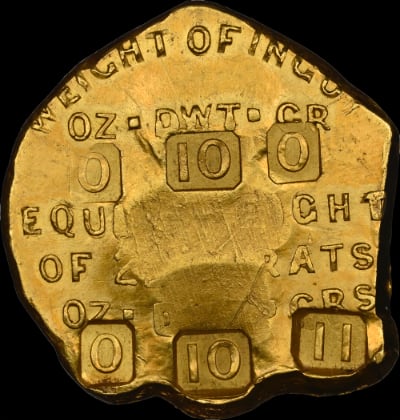The 1852 Adelaide Ingots - Innovation That Averted Economic Catastrophe
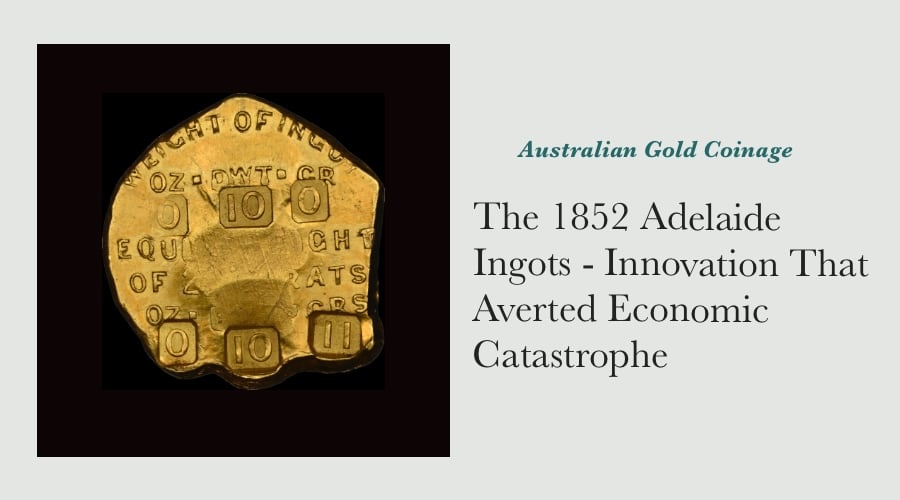
The Adelaide Ingots are numismatic items that most collectors only see or read about in a Rennik’s catalogue. Even though they’re described in some detail, I’d hazard to suggest that most collectors are only notionally aware of their existence and not necessarily their unique place in Australia’s economic history.
I’ve been a dealer for the better part of 3 decades now, and even though I was employed by Monetarium (the dealers who sourced and sold the only Adelaide Ingots to ever appear on the open market) for a decade, I had never seen these items in the hand myself.
There are many more historic Australian numismatic items than hours in the week, so I only focus my research efforts on items I am called upon to handle.
Type I Adelaide Ingot - Hunt-Deacon 3
Image Source: Numismatic Guaranty Corporation
I believe I have a decent understanding of the evolution of the Adelaide Assay Office and have handled numerous Adelaide Pounds over the years, yet I’d never really spent any meaningful amount of time studying the Adelaide Ingots that preceded them.
That changed in the early months of 2022 when I was approached by a Perth businessman who expressed interest in acquiring an Australian numismatic item of international importance. He further stated that a seven-figure price tag would not be an issue for the right item. He was not an experienced coin collector per se but wanted to leave several quality tangible assets for his family.
Given the importance of the situation, I advised the client that before we started shopping I’d prepare a list of potential acquisitions and bring him up to speed via a short presentation.
The presentation covered the short list of items that would meet his criteria - their position in our numismatic history; how often they turned up at auction and the likely price range such items would be expected to fetch.
He was satisfied with that overview, and after a few pointed questions instructed me to get in touch when I had something for him to consider.
Two potential items that became available were the Adelaide Ingots, and before I declared myself ready to make a case for them, I resolved to embark on what I figured would be a short burst of research.
That research has given me a much deeper appreciation for the importance these incredible heirlooms have to world economic history. As can be the way with Australian numismatics, that research also raised just as many questions as it answered.
Ingots As Relics of the World’s Gold Booms
History shows that the early days of any gold rush are marked by chaos, opportunity and a quick evolution of infrastructure. Vast quantities of gold can be mined and refined into a convertible form well before any mint is established.
The two largest gold rushes before those in Australia in the 1850s were in Brazil (spanning from the 1690s right throughout the 18th century) and California from 1849. Ingots from these gold rushes are highly prized by historians, economists and collectors for their tangible links to two of the most influential events in world economic history.
Such is the appeal of gold ingots as relics and collectables that a museum was conceived to display the largest collection of gold ingots in the world.
Degussa Goldhandel GmbH is a well-known gold bar, bullion coin and numismatic trading company in Germany - they are the current Custodian of “what is known as “The Industry Collection” of gold ingots. This collection was formed by N.M. Rothschild & Sons (Australia) Limited. The main area of focus of the collection is on gold ingots issued since 1971, it also holds a small number of “historical” 400oz good delivery bars issued before 1971. It includes 1,084 gold bars from 35 different countries.
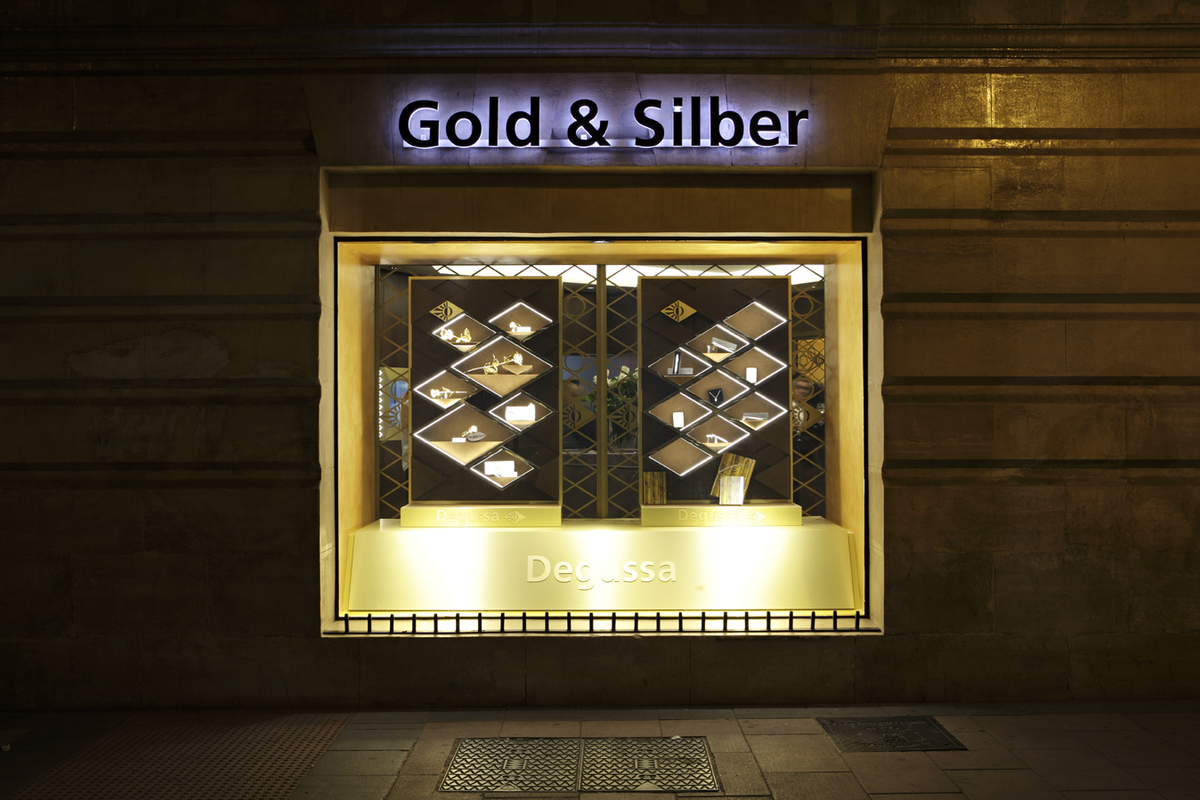
Degussa Goldhandel GmbH
This collection has been exhibited numerous times internationally - in Germany; Singapore; Dubai; Thailand; USA; London and at the Perth Mint. Hundreds of thousands of people have viewed the collection in the various locations it has been displayed.
The Brazilian Gold Rush and Ingots
Gold was discovered in Brazil in the 1690s, sparking a gold rush that lasted more than a century. 400,000 Portuguese miners worked the fields, alongside 500,000 African slaves. More than 800 tonnes of gold was shipped to the Portuguese monarchy across the 18th century. “The white and yellow metals not only failed to bring prosperity to Iberia, they failed to bring long-term prosperity to Latin America.”
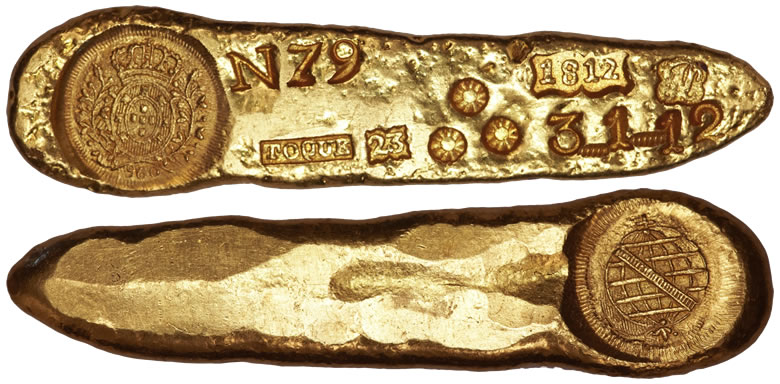
1812 Bazilian Gold Ingot
Image Source: Heritage Auction Galleries
The pseudo-monetary gold ingots of Brazil, made from 1778 to 1833, are among the rarest items in South American numismatics. They are comparable to the U.S. pioneer gold issues of the California Gold Rush of 1848–1855, as they were made from natural gold that merchants and prospectors brought into official foundries for testing, smelting, marking and taxation.
218 of these ingots are known to exist, “a bit over half” are in private hands. The most recent public sale for one of these (in August 2022) was for US$174,000 (AUD$260,000). In some ways it is astonishing these ingots are held in such high regard when the full benefits of the Brazilian gold rush were not felt either in Brazil or Portugal.
The Californian Gold Rush and Ingots
Gold was discovered at Sutter’s Mill (California) on January 24th, 1848, sparking the California Gold Rush that lasted close to a decade. 300,000 miners surged to the fields. Legally, California was “the Wild West”, a lawless place.
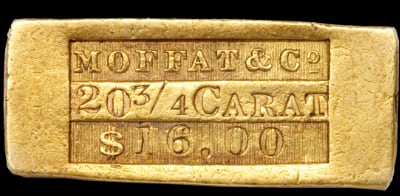
California Gold Ingot
Image Source: PCGS
At least 13 different private mints and refineries were established in the months that followed the discovery of gold in 1848. More than 40 different ingots from private (non-government) refiners were recovered from the shipwreck of the SS Central America alone. When they were first marketed, advertised prices for these ingots began at US$85,000, one particular set was offered for US$3 million.
Australia’s Gold Rushes
Gold was discovered in Bathurst (New South Wales) on February 12th, 1851, and then on July 1st, 1851 in Clunes (Victoria). It didn’t take long for the effects to ripple across the Australian continent - in December 1851: “The streets of Adelaide were deserted; houses were abandoned by their tenants; rents fell and property became unmarketable. The shops of our retailers presented their tempting wares in vain. There was a general arrest put on all business…”
16,000 out of a total of approximately 37,000 adult South Australian males had left for the Victorian goldfields. “For the colony as a whole, the threat was that a banking crisis would be added to its already acute troubles.” The colonial government set itself two objectives - to provide an incentive for miners to return with their capital and to facilitate trade within the colony.
It was in these circumstances that the Adelaide Assay Office was conceived.
The 1852 Adelaide Ingots are counted among Australia’s most historic numismatic items - they were the very first items produced by the Adelaide Assay Office following the discovery of gold at Mount Alexander (in Victoria) in November 1851. These enigmatic slabs of gold are incredibly rare - just 2 have been sighted in private hands anywhere in the world in the past century.
According to a noted authority on the Adelaide Assay Office, James Hunt-Deacon, “The introduction of the Bullion Act and the subsequent coinage … was a masterly stroke of the legislature, and played no small part in averting economic catastrophe and laying the foundation for a stabilised currency.”[1]
A Schema of the Adelaide Assay Office Ingots
A taxonomy of the Adelaide Assay Office Ingots has been carried out 3 times previously - by Dr Arthur Andrews in 1921 “Australasian Tokens and Coins” dated 1921; by James Hun-Deacon in 1965 in “The Ingots and Assay Office Pieces of South Australia” and by Dion Skinner as editor of the 8th edition of “Renniks Australian Coin and Banknote Values”, published in 1974.
In situations where I’m working with disparate information across several sources, I find it useful to compile all of the known data into one location. This verifies the available facts and helps identify incorrect or duplicated information. The table below has been built using information from the above 3 texts mentioned, as well as the Quartermaster Collection auction catalogue and other sources:
| Hunt Deacon | Renniks | Andrews | Type | 22ct Weight | Gross Weight | Weight (g) | Measurements | Origin | Currently Held |
| Hunt-Deacon 1 | Renniks 1 | 1 | 15dwt 7gr | 16dwt 0 gr | 23.7812 | 26mm * 25mm | Baldwin ca 1938 | Unknown | |
| Hunt-Deacon 2 | Renniks 2 | 1 | 14dwt 17gr | 15dwt 11gr | 22.8740 | 25mm * 28.5mm | Unknown | Dixson Collection 638 | |
| Hunt-Deacon 3 | Renniks 3 | 1 | 10dwt 0gr | 10dwt 11gr | 15.5517 | 25mm * 23.5mm | Nobleman 693 | Private collector | |
| Hunt-Deacon 4 | Renniks 4 | 2 | 5dwt 8gr | 5dwt 15gr | 8.2943 | 40mm * 20mm (ex Renniks) | Murdoch 597 | Unknown | |
| Hunt-Deacon 5 | Unlisted | 2 | 5dwt 8gr | 5dwt 15gr | 8.34 (ex BM) | 40.50mm * 27mm | Nobleman 694 | British Museum | |
| Hunt-Deacon 6 | Renniks 5 | 2 | 5dwt 8gr | 5dwt 14gr | 8.0999 | 43.20mm * 27.60mm | Taffs | Private collector | |
| Hunt-Deacon 7 | Renniks 6 | Andrews 720 | 2 | 5dwt 5gr | 5dwt 11gr | 7.4519 | 44mm * 28mm | Thomas; Reynolds and Sawtell | Hunt-Deacon states held by Dixson Collection in SLNSW |
| Hunt-Deacon 8 | Renniks 7 | Andrews 721 | 2 | 4dwt 19gr | 5dwt 1gr | 7.4519 | 44mm * 28mm | Heuzenroder | AGSA |
The Provenances of Each Known Adelaide Ingot
One of the ways I resolved to get absolute clarity not only on the number of Ingots that were in existence but more importantly on the number of Ingots that were (potentially) available for collectors to buy was to build out as much provenance information as possible on each example. The information below captures the information I've been able to obtain to date:
HUNT-DEACON 1 - BALDWIN
This example is listed by Hunt-Deacon as having been “Purchased by A.H. Baldwin & Sons, London, in 1938-39, and later sold to a private collector.” [2] No additional details are known about this Ingot. There is some discussion in the numismatic trade in the United Kingdom that it may be coming to market at some stage in the coming years.
HUNT-DEACON 2 - DIXSON 638
This example is identified by Hunt-Deacon as being “In the collection of the late Sir William Dixson.” This example is listed in Albert Henry Spencer’s catalogue of the Dixson collection, prepared in November 1957. On page 15, it is one part of item 75:
Adelaide £5, Specimen in Silver 1852; (b) Specimen Gold Dump 0/14/17; (c) scissel piece, stamped (d) Scissel piece, gold, stamped; (e) Another scissile piece, gold, stamped.
As an aside, it is a telling indication of the depth and breadth of the Dixson collection that these incredibly rare and historic items can be combined into one lot!
Item 0638 in the Dixson collection is currently described as: “South Australian Ingot, circa 1852.“
Photographs of the item have not been posted online, but I have personally sighted and examined this example. The description advises the dimensions are (25 mm x 28.5 mm).
HUNT-DEACON 3 - NOBLEMAN 693 / QM
This example is identified by Hunt-Deacon as being “In the collection of A Nobleman until 1922…” The lot description in the catalogue of the Nobleman auction (Sotheby’s London, 1922) is as follows:
“693. Gold. South Australia. An irregular Ingot, stamped on one side
WEIGHT OF INGOT O IO O EQUIVT WEIGHT OF 22 CARATS O IO II
and on the other side, a shield bearing S. A. crowned above and below in two lines carats 23. Unpublished, very fine and very rare if not unique [PI. XVI]”
The auctioneer did not provide any information on the provenance of this piece before it was acquired by the Nobleman collection. A handwritten notation in the margins of a publicly available copy of the auction catalogue indicates it was purchased by the dealers Spink and Son of London for £185. This example is currently held in a private collection.
HUNT-DEACON 4 - MURDOCH
This item is described by Hunt-Deacon as being “In the collection of John G Murdoch until 1903…previous owners unknown.” This section of the Murdoch collection was sold by Sotheby, Wilkinson and Hodge in London in July 1903. The lot in the Murdoch catalogue had the following description:
“597 GOLD. Ingot Money, of oblong form, having the corners cut off, and bearing the impress of a large circular stamp giving the following particulars: 5 DWT 8 gr / 5dwt / 15gr
22CARATS 5 15, outside this, to one end of the ingot, are the following marks from punches: S. A. crowned within a shield, 1, 8, 23 CARATS, of the highest rarity, if not unique [P1. VI]”
Handwritten notations on a publicly available copy of the auction catalogue state that it was bought by Spink and Son for £18 and 15/-.
HUNT-DEACON 5 - BRITISH MUSEUM
Hunt-Deacon states this example was “In the collection of A Nobleman up to 1922…being acquired by the British Museum.” The Nobleman auction was held by Sotheby, Wilkinson & Hodge in April 1922. The description for Lot 694 was:
“Gold. South Australia. An oblong rolled Ingot, stamped as the last, but the weights are 058 and 0515 and all is within a circle, below this is S. A. crowned in a shield, i, 8, 23 carats in oblong indents {vide Dr. Andrews, Australian Coins and Tokens, 720 and 721), very fine, and very rare [Pl. XVI]”
The auctioneer did not provide any information at all on the provenance. A handwritten notation in the margins of a publicly available copy of the auction catalogue indicates it was purchased by the dealers Spink and Son of London for £105.
HUNT-DEACON 6 - TAFFS / QM
This ingot was plated as Type 6 in Hunt-Deacon's work "The Ingots and Assay Office Pieces" (1954). Hunt-Deacon listed it as being in the collection of Herbert W. Taffs of London. Reference to the piece can also be found in the May 1912 proceedings of the British Numismatic Society where Mr H.W. Taffs exhibited a "gold ingot or plate issued from the Adelaide mint in 1852.”
Taffs was a clerical officer at the War Office and Royal Almonry. He was a founder member of the British Numismatic Society in 1903 and editor of the first twenty-one volumes of the BNJ. During the Second World War he spent much time sorting the coins that were donated to the Red Cross for sale. His extensive collection of British, Colonial and Foreign Coins, including tokens, especially 17th century, was sold in 927 lots at Glendinings on 21-23 November 1956.
This example is currently held in a private collection.
HUNT-DEACON 7 - DIXSON COLLECTION
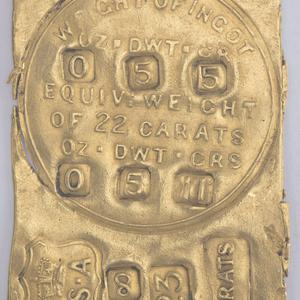
HUNT-DEACON 7 - DIXSON COLLECTION
Image Source: State Library of New South Wales
Hunt-Deacon states that this ingot was: “Owned by the Hon. Thomas Reynolds, Messrs E. Sawtell and Thomas W. Walters of South Australia; and from 1912 in the possession of the late Sir William Dixson, of Sydney, New South Wales. This specimen is illustrated in Gill's Coinage and Currency of South Australia, Plate XXI.”
Thomas Reynolds was the 5th Premier of South Australia; Edwin Sawtell was the first optician and watchmaker in South Australia; Thomas Walters was a respected headmaster. The examples held in the Dixson collection (639 ~ 642) all appear to be electrotypes or forgeries. I have not yet examined a genuine example of this ingot in the Dixson collection, and am yet to verify the proceedings of the David Gee case to determine if he was charged with the theft of it, and if he was, whether it was returned to the State Library of New South Wales.
HUNT-DEACON 8 - Art Gallery of South Australia
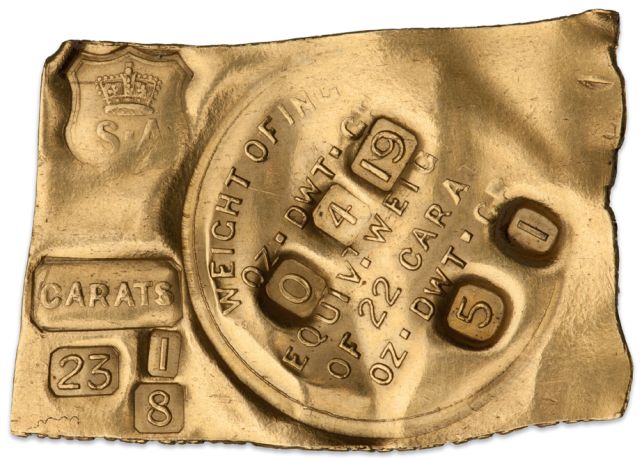
HUNT-DEACON 8 - Art Gallery of South Australia
Image Source: Art Gallery of South Australia
Hunt-Deacon states this ingot was “In the Heuzenroder Collection to 1890; then in possession of Mrs Henry Heuzenroder until 1912 when it was purchased by the South Australian Museum, now in the National Gallery of South Australia.”
These are the specifications of the ingot, as recorded by Hunt-Deacon: 4dwt 19gr / 5dwt / 1gr. The full description of the Ingot as acquired by the Art Gallery of South Australia is:
“Joshua PAYNE, die-sinker and stamper, born Britain 1810, arrived Australia, c.1849, died Adelaide 1889, Adelaide Assay Office Ingot, 1852, Adelaide gold, irregular rectangular, 4.2 x 2.8 cm uniface.
Impressed marks of a circular stamp recording Weight of Ingot, Carat stamp and Assay Mark (a shield with S.A. with a crown above). Purchase 1912.”
AGSA Accession Number: NC00008.
Questions and Challenges
Question 1 - Will the Baldwin example re-appear on the market for the first time in more than 8 decades?
Question 2 - Where is the original and genuine example of Hunt-Deacon 7?
Questions 3 Onwards -
An interesting series of comments on the Adelaide Ingots were made by Tom Hanley and published in the NAA Journal:
“Dixson acquired two specimens of the Adelaide ingots. The collection also has examples of copies of the ingots that were done recently. I suggested to the library that these should be stamped S for specimen or F for facsimile, but to date, this has not been done. Deacon lists a total of eight ingots. His fourth is identified as being in the Murdoch Sale of 1903, but Dixson claims that the Murdoch example may be spurious:
“At the Murdoch sale in London a few years ago an Adelaide ingot was disposed of. It is said that Mr Murdoch despaired of ever getting one and had a set of dies made. He struck one out of solid gold and destroyed the dies. It is presumed he copied an electrotype but which die is not certain. Dr Watson states that only five ingots were struck.”
These comments pose several further questions:
- Was Hanley suggesting the (2) genuine Ingots be physically stamped with an “S”? Surely this was a preposterous step to take to discern genuine examples from electrotypes and fakes.
- Does Dixson’s comment explain why the Murdoch example has not been sighted since 1903?
- If Dixson’s handwritten note is dated July 1903, that is odd as the Murdoch auction of this section of his collection was held July 21st - 29th, 1903.
- Does Dr Watson mean “only five ingots were struck“ by Murdoch?
Given the nature of the questions outlined above and the importance they have, I'll be researching these historic gild ingots for some years to come.
End Notes
[1] Hunt-Deacon; James, "The Ingots and Assay Office Pieces of South Australia", Hawthorn Press, Melbourne, , p iii.
[2] James Hunt Deacon, The Ingots and Assay Office Pieces of South Australia, Hawthorn Press, Melbourne, 1965, p50.
[3] Carlyon-Britton; P.W.P, "Proceedings of the British Numismatic Society“, May 22nd 1912, p 418.

